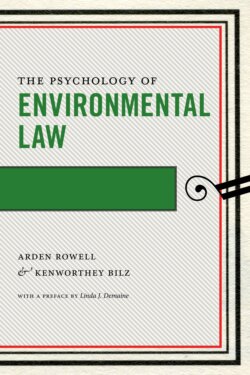Читать книгу The Psychology of Environmental Law - Arden Rowell - Страница 12
На сайте Литреса книга снята с продажи.
What Is Environmental About Environmental Law?
ОглавлениеEnvironmental law is law, of course, but it is also environmental. Indeed, a key attribute of environmental law is that it concerns the environment: the surroundings in which humans, plants, and animals live. This is not merely a tautology; it is a defining feature of the field that differentiates it from most other areas of law, which seek to regulate human behavior directly.
Richard Lazarus has argued that what is “environmental” about environmental law is its focus on environmental or ecological injury; that is, on harm that accrues to the environment, rather than (directly) to people (Lazarus, 2000). Lazarus’s analysis, first presented in his article “Restoring What’s Environmental About Environmental Law in the Supreme Court” (2000) and further articulated in his book The Making of Environmental Law (2004), seeks to articulate what it is that makes environmental harm distinctively challenging to address and resolve through typical legal approaches. Explaining that “[e]nvironmental law is concerned, in the first instance, with impacts on the natural environment,” Lazarus identifies ecological injury as the common denominator among environmental laws—and as the common source of the special challenges that environmental law presents for lawmaking. Importantly, Lazarus highlights that ecological injury is often irreversible, catastrophic, and persistent; is both physically and temporally distant; implicates uncertainty and risk; has multiple causes; and has a “noneconomic, nonhuman character” (Lazarus, 2000, p. 748).
Lazarus’s analysis has been widely excerpted in environmental law textbooks and is frequently used as a jumping-off point for environmental scholarship. In part because of Lazarus, then, a now familiar claim within environmental scholarship is the notion that environmental law is distinctive because it addresses environmental harm. A number of legal scholars—including Lazarus (2000)—have gone one step further, however, to argue that legal institutions (such as the Supreme Court) and legal decision making cannot effectively manage environmental injury without understanding and addressing the qualities that make environmental injury distinctive. Lazarus goes on to identify a series of doctrines—in property law, Article III standing, Dormant Commerce Clause jurisprudence, regulatory takings, and even corporate law jurisprudence—that relate to environmental injury and that are prone to mistake and mismanagement without a full understanding of the ecological nature of environmental injury.
Other scholars have built on Lazarus’s argument that the law needs to address distinctive qualities of environmental injury in order to be effective. Such arguments range from doctrinal claims that elaborate on the idea that doctrines of standing need to adjust to allow for claims of environmental injury (Nash, 2008), to claims that forms of environmental legal decision making cannot effectively address environmental injury because of challenges to expressing environmental goods meaningfully in economic terms (Ackerman & Heinzerling, 2002). Other scholars have emphasized the mismatch between the complexity of nature and the simplified account of nature upon which environmental laws often seem to rely (Doremus, 2006; Fischman, 2007). Still other scholars, addressing similar concerns (though not following Lazarus in particular) have made related legal and institutional critiques, for example, by arguing that environmental injustice is meaningfully distinct from other forms of injustice and deserves its own recognition and management (Bullard, 1993). Finally, scholars, most notably Elinor Ostrom, have also argued that different types of environmental injury (or types of environmental resources) should be understood to call for different kinds of management, depending upon their characteristics and qualities (Ostrom, 1990).
